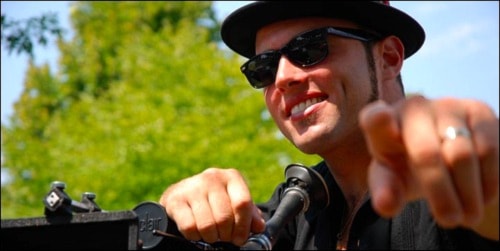If you are like many families, you have a box in storage with some old family movies that you can’t watch. The projector died or was lost years before. What you need is Newsreel Productions, owned and operated by Oliver Gläser.
“My main service nowadays is transferring people’s old home movies and archiving old Super 8 and 16 mm film to High Definition (HD),” said Oliver.
The business was the first of its kind in Western Canada with equipment that Gläser built from scratch. It is now the only professional quality small gauge transfer company in Western Canada.
“I get everything from grandparents with their old films of their kids growing up, to movie companies who want me to do title sequences for their films or music videos, commercials or that sort of stuff,” said Oliver, who added that he has had clients from as far away as Brazil, Germany, Holland all over the U.S. and Canada.
Oliver is a cinematographer by trade —aka a Director of Photography. He explains that when he used to live in Vancouver his job was designing the lighting and operating the camera on movies; the guy who sits next to the director and makes the calls on lighting and where the camera moves.
“But the hours were long and it is not really conducive to family life so we moved out here.” He had been doing the film transfer business while in Vancouver and he continues to provide that service from the Boundary.
He scans each and every frame of film and transfers each frame to a distinct frame of video.
“Most of my clients have their film transferred to hard drive so they can edit it on their computer but for some people a DVD or a Blue-ray disc is all they want so they can pop it in their machine and watch it.”
He is set up to handle any 8 mm, Super 8, 16 mm or Super 16 negative or reversal film; and job size is no limitation.
Oliver said that a film shot in 1927 was the earliest film he’s transferred—all the way up to modern stuff that people have shot only a week before transfer.
Often some of the film is missing, cracked, broken, cupped, dried out or it might have a vinegary smell, which is a sign the film is breaking down.
“When you think about it some of those films are 75 years old. When you edit it and clean it and check the splices and fix it you end up getting a film that looks like it could have been shot yesterday.”
His website (newsreelproductions. com) has some great examples of some of the films that he has transferred, including shots of logging equipment in the 40’s and kids playing stickball in Toronto streets in the 1930’s and 40’s.
Oliver insists that there is something about film that is more visceral than shooting with video. “If you have ever been forced to sit through somebodies holiday slideshow or if you have ever shot a video of a vacation and you sit back and you try and watch it—it is generally everything has been recorded and it’s slow and it’s boring and you don’t really remember why you shot it. Whereas film is a very different experience because film was so time limited. You only had three moments a roll so you would only press the trigger on those moments that most stand out.”
“I have heard it compared to memory —you don’t remember everything but you remember the highlights and film is like the highlight reel of things.”
Oliver still shoots film. “That’s why I built the machine to begin with - to transfer the film that I was shooting myself.”
He studied film in North Vancouver at Capilano College—now Capilano University—but states that he learned his trade as a professional cinematographer, for the most part, not in school but through work.
The Newsreel Productions webpage landed Oliver a job in Italy last summer. His webpage logo is a Bell and Howell Filmo 70 DA—a 1930’s era 16 mm camera.
Oliver happens to own one and was hired to return to the beaches of Sicily to recreate some shots that were originally filmed with the same time of equipment during the Allied landing in 1943. This is one of the many stories told on his website.
“There is really no higher quality transfer than this and when you get into HD for Super 8 there is really not much more you can get. You see every pixel, you see every grain of film with this resolution.”
